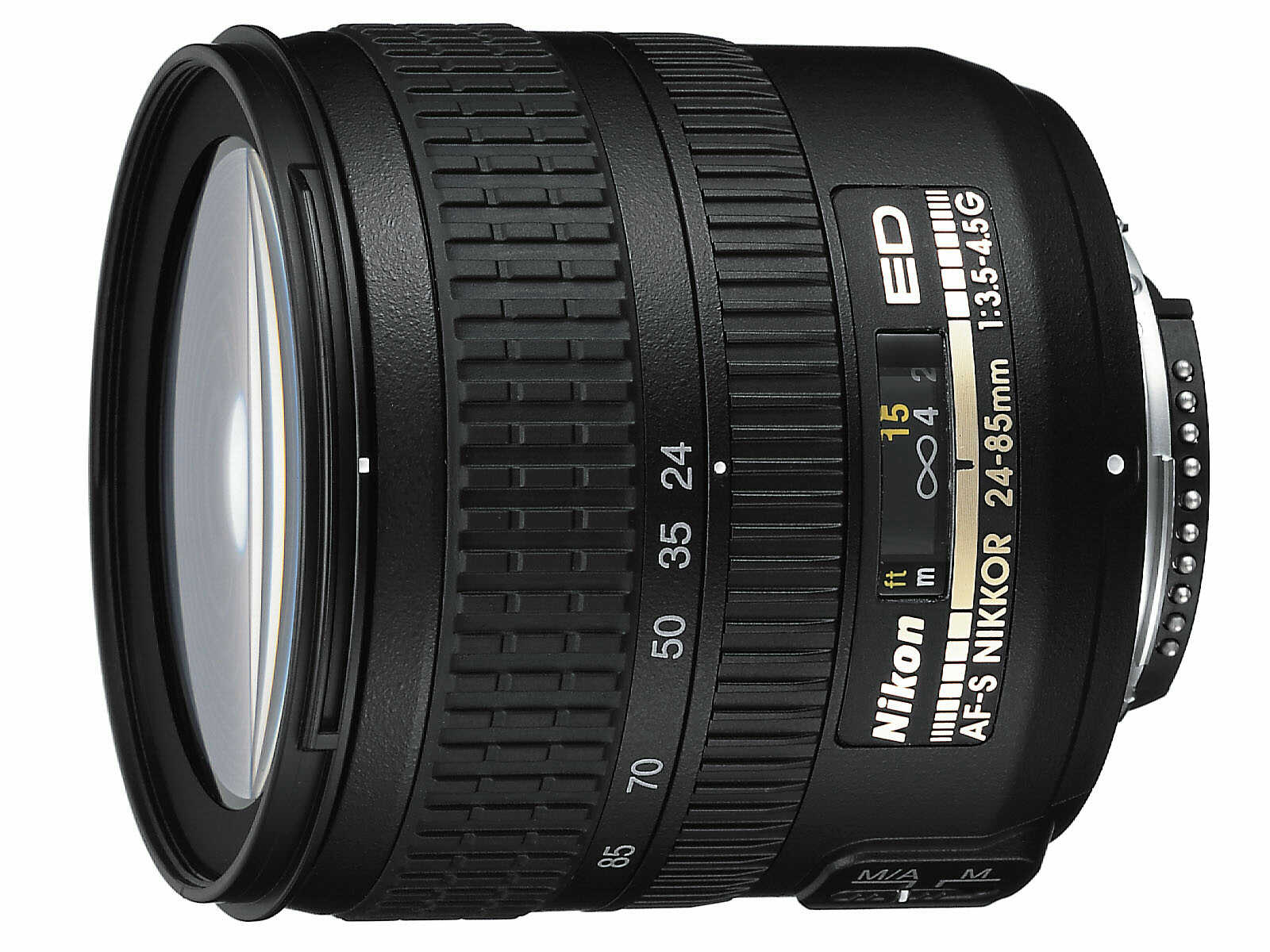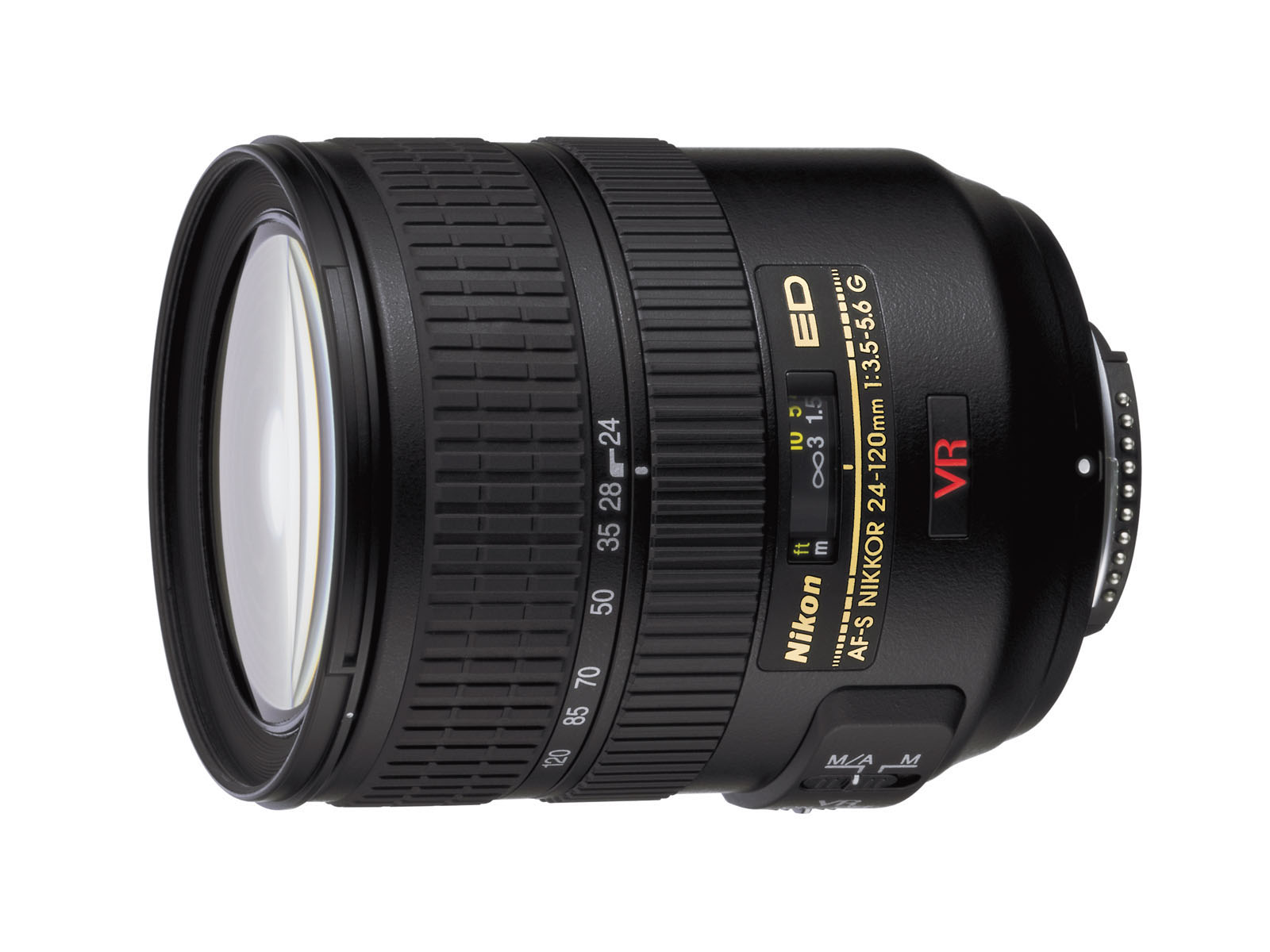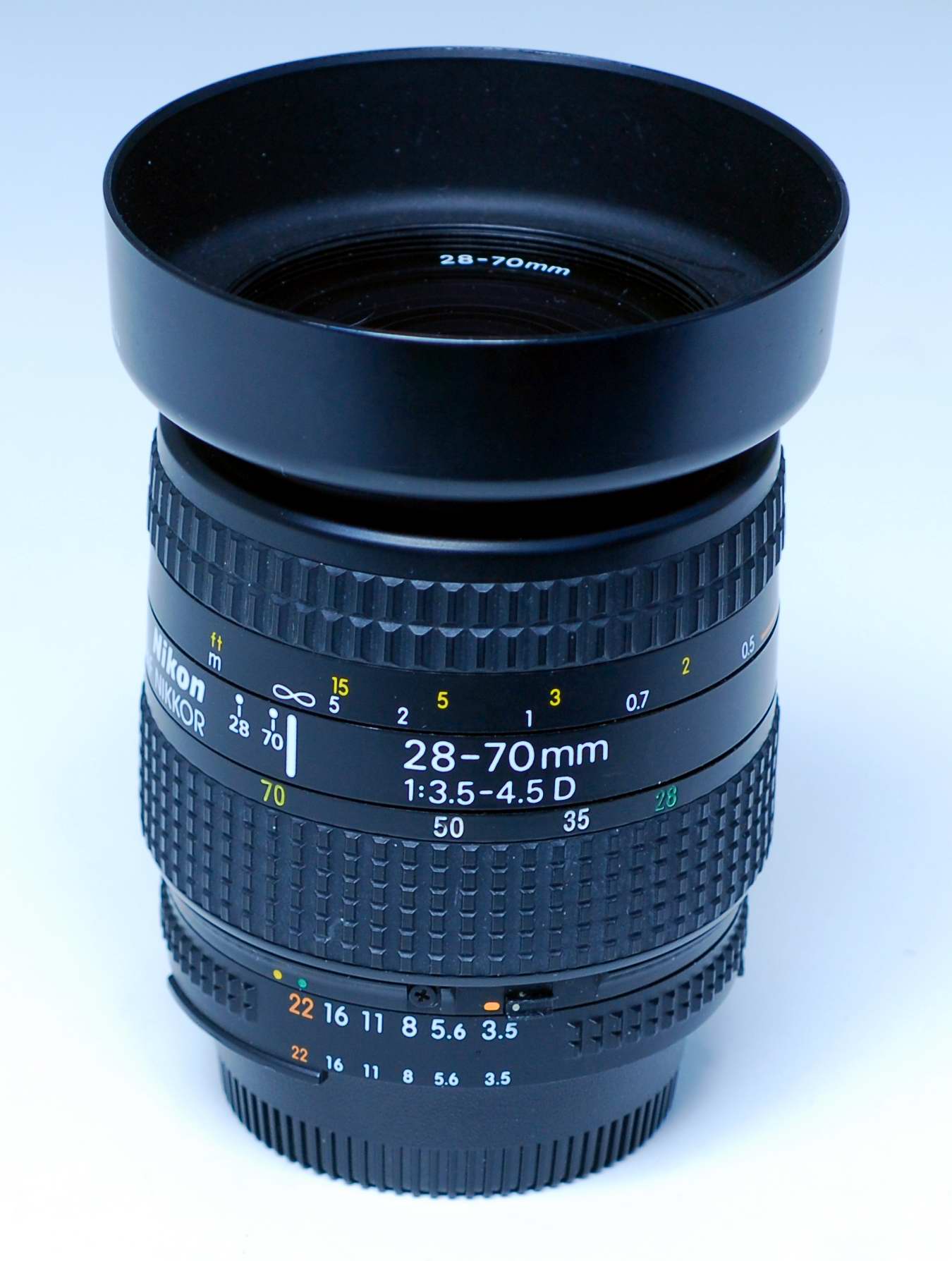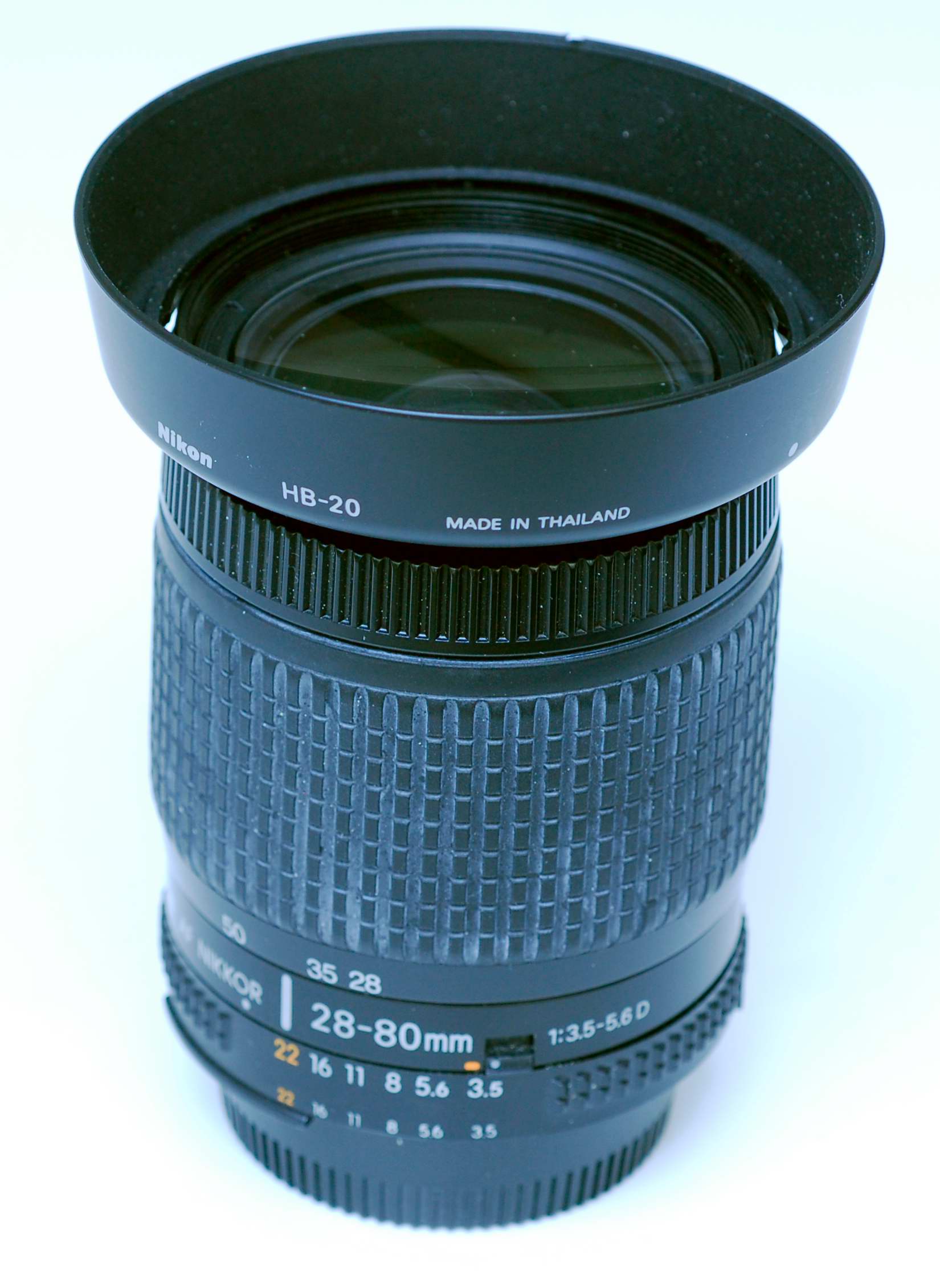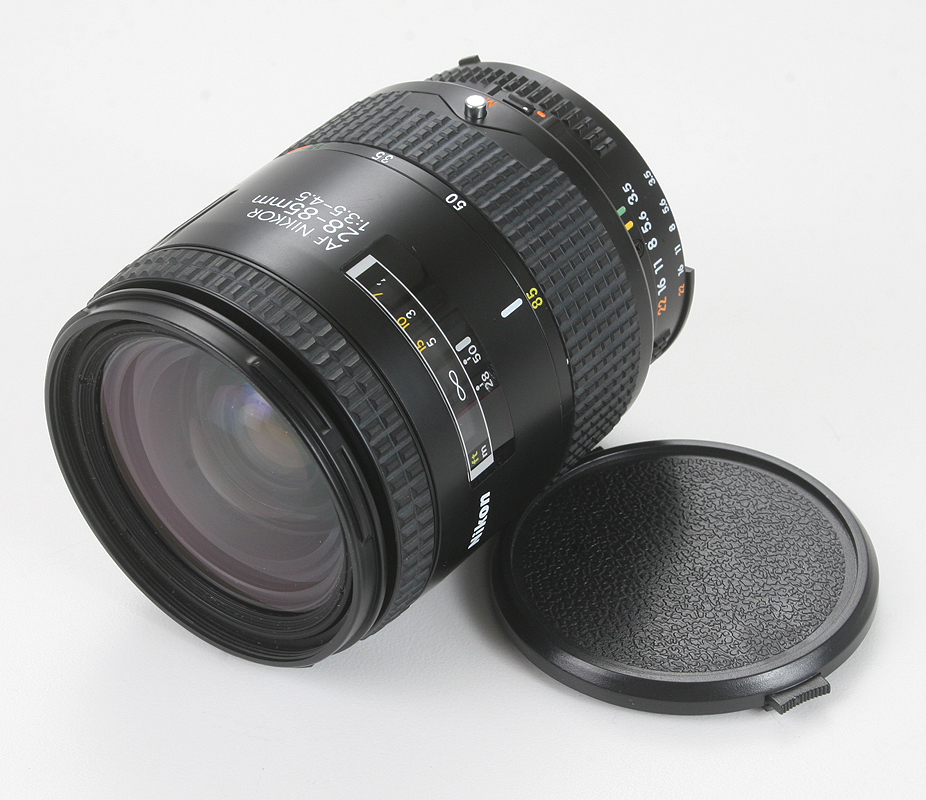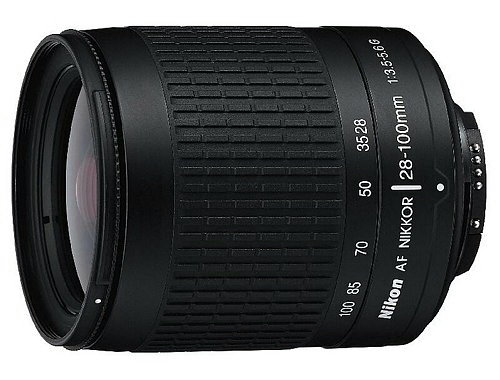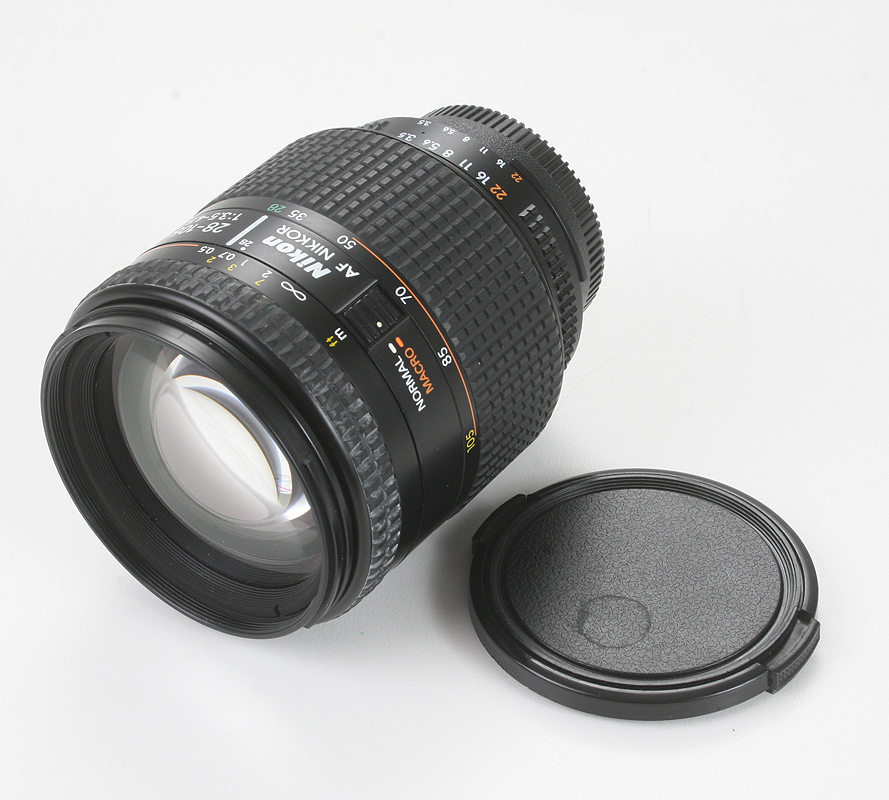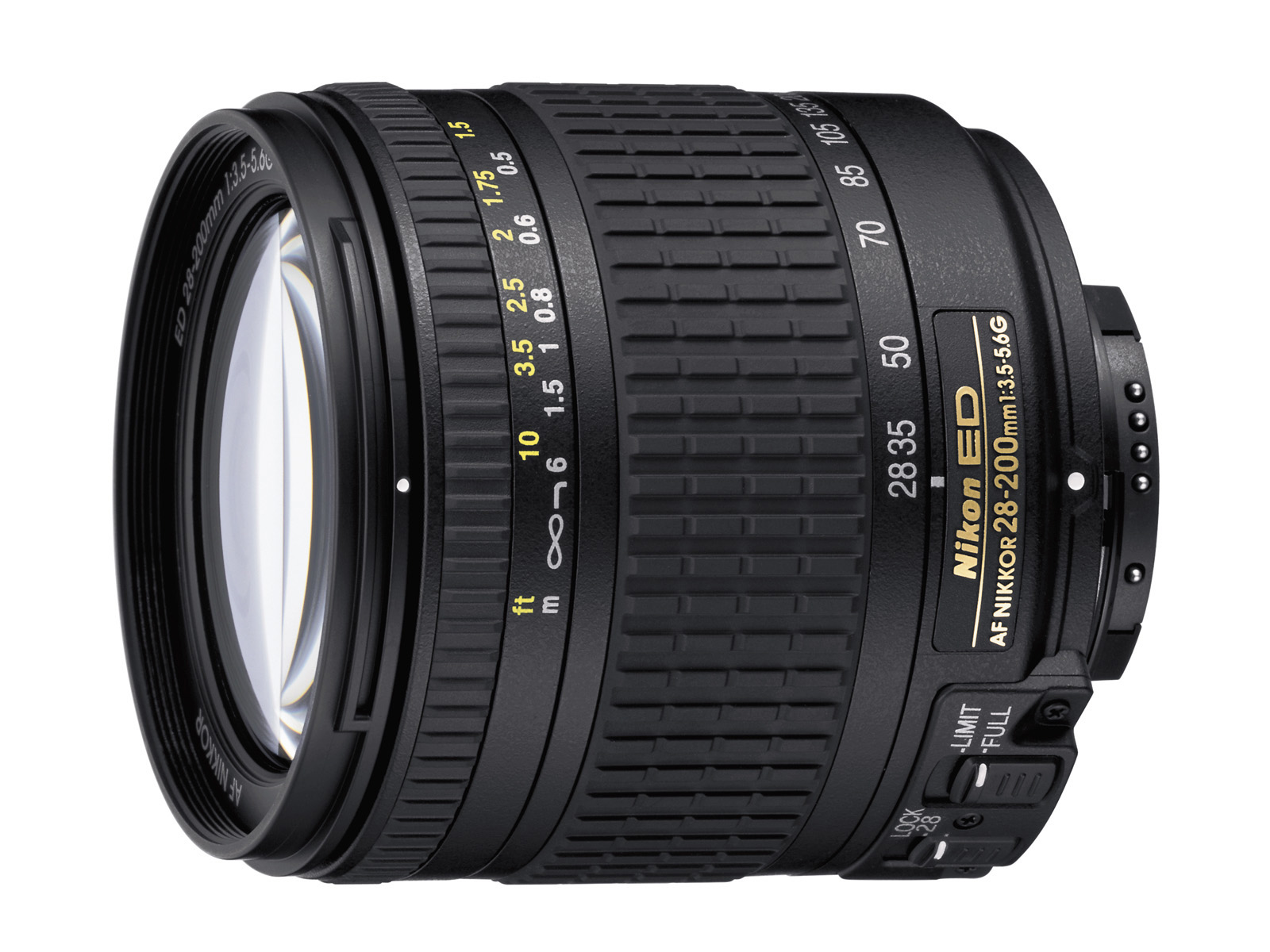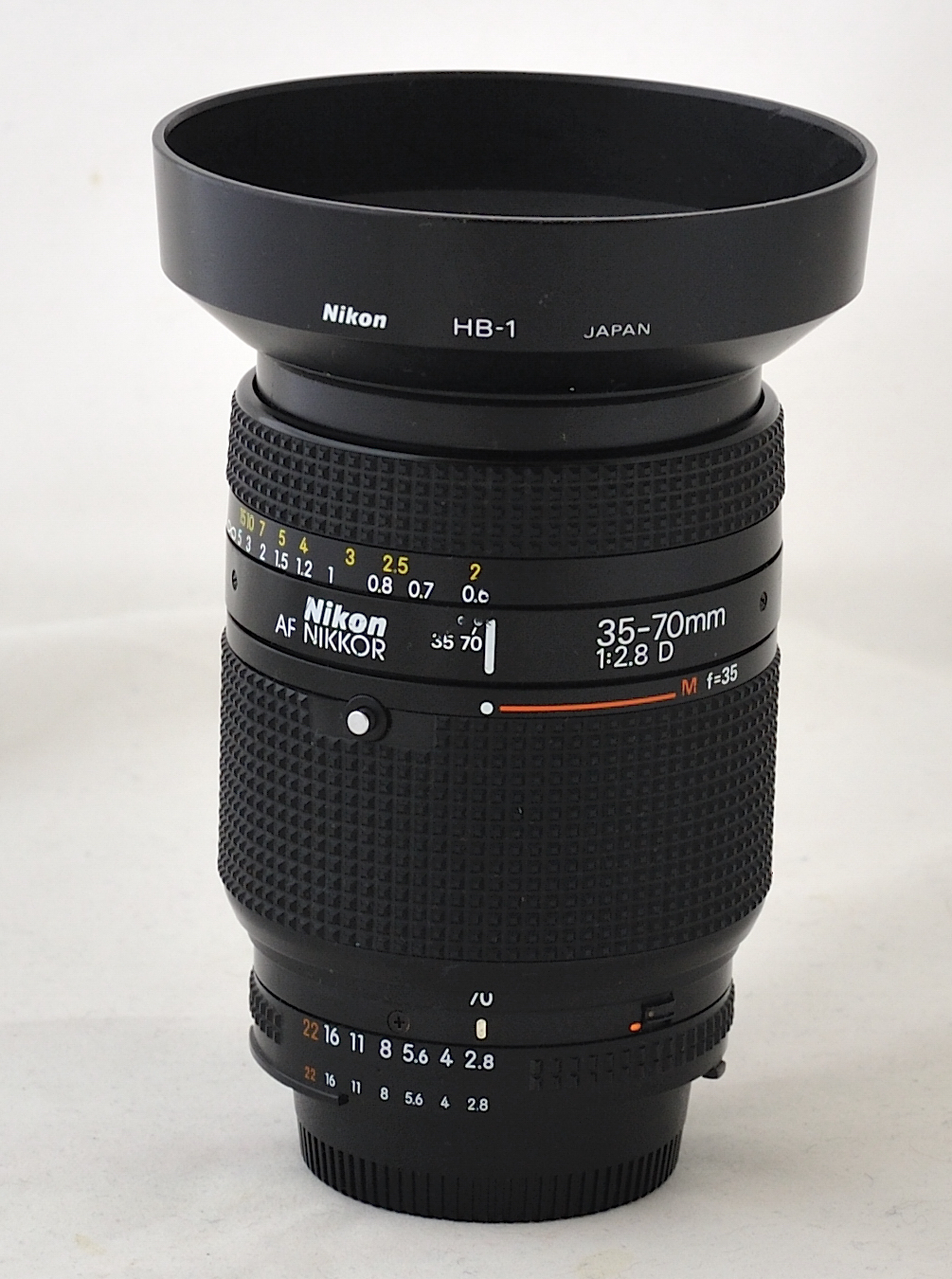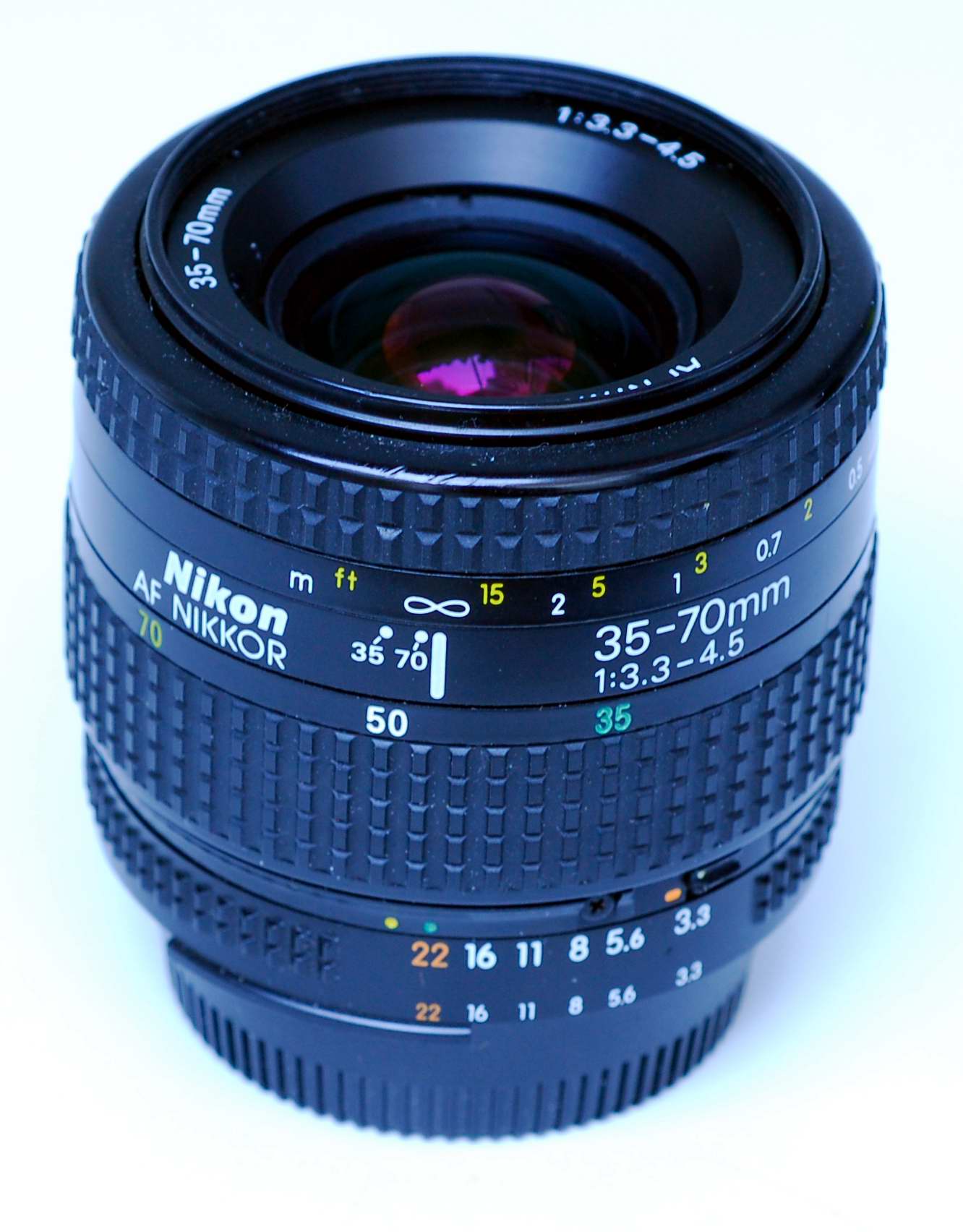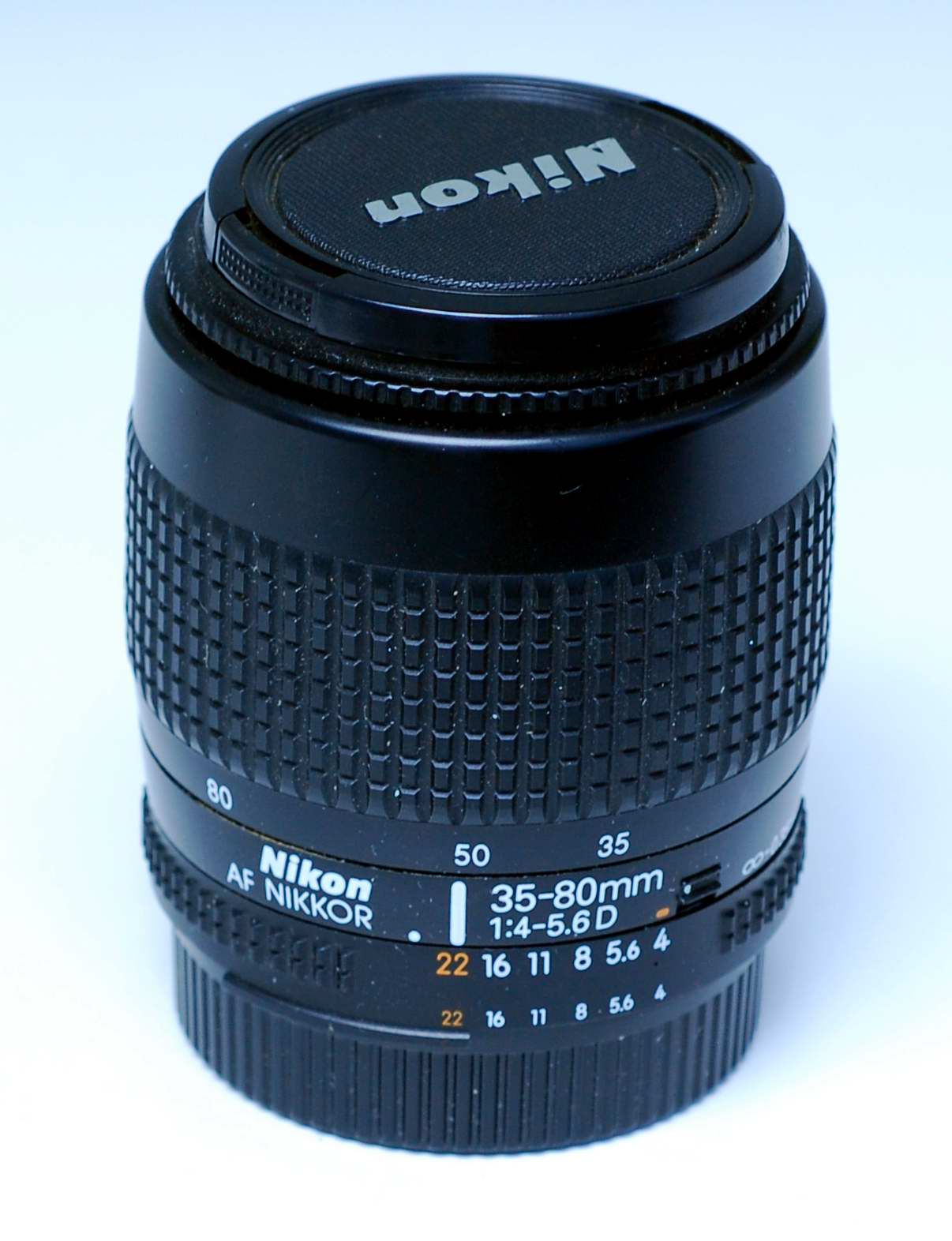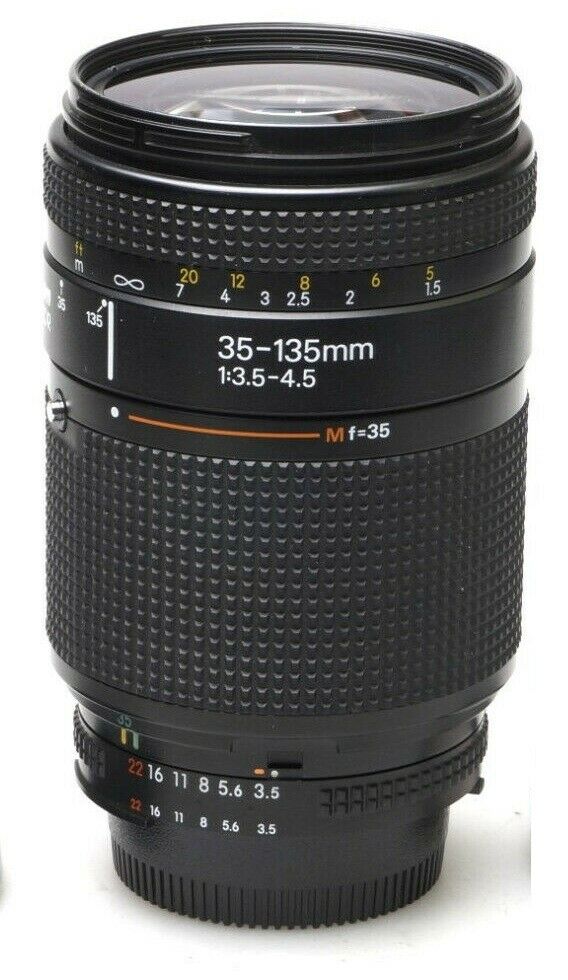Nikkor autofocus standard zoomlenses(A standard zoomlens is a zoomlens incorporating the standard 50mm focal length) For technical specifications see this matrix
AF-Nikkor 3.3-4.5/24-50 mm. This underrated lens, introduced in December 1987, is a very nice standard zoom lens, to be used on nearly all film and digital SLR's. Especially the last (= D-version anno 1995) is an excellent performer. It has a fast AF and almost no distortion, when used wide open. On a digital DX-SLR the viewing angle is 36-75 mm., which makes it a good reporter's lens. It has 9 individual elements, a rather common 62mm. filter thread, minimum focus of 50 cm. and is weighing in at just 355 gram. The best hood is the pictured HB-1. The production of this lens stopped in 2006.
AF-S Nikkor 2.8/24-70 mm. G IF-ED This heavy (900 gram) and relatively fast (f/1:2.8 at all focal lengths) professional zoom lens was introduced in August 2007. It has a complex optical construction of 15 elements in 11 groups. Three lenses - one of which is the front lens - are aspheric and three others are made of ED-glass. Some lenses are coated on the camera side with special nano-coating to avoid internal reflection and eliminate ghost. Nine aperture blades are giving each image a nice 'bokeh'. Because of the built-in Silent Wave Motor auto focus is very fast. Unfortunately the lens has no aperture ring - as it has the G-mount - thus difficult to use on older SLR's. Used on a DX-format SLR the viewing angle is 36-105 mm. The shortest focusing distance is 38 cm., filter thread is 77mm. and the best hood is the HB-40.
AF-Nikkor 2.8-4/24-85 mm. D IF This fast and very nice performer was introduced in October 2000. It has an optical construction of 15 elements (of which 2 are aspheric) in 11 groups, nine aperture blades and a minimum focusing distance of 21 cm.! It is a bit cheaper and lighter (545 gram) than the lens mentioned before, ánd it has an aperture ring! Although it has no built-in motor focusing is relatively fast. Best hood is HB-25.
AF-S Nikkor 3.5-4.5/24-85 mm. G IF-ED
This lens - introduced in June 2002 - is the G-version of the lens mentioned above. It has 15 elements (of which one is aspheric and one is made of ED-glass) in 12 groups, seven aperture blades, internal focusing (down to 38 cm.) by a fast Silent Wave Motor. The lens weighs in at 400 gram. It can only be used on modern cameras, due to the lack of an aperture ring. Best hood is HB-28.
AF-Nikkor 3.5-5.6/24-120 mm. D IF
This popular lens was introduced in October 1996. The picture above shows the VR-version which was introduced in 2003. The older version - of which the production stopped in 2002 - has an aperture ring and has an optical construction of 15 elements (of which 2 are aspheric) in 11 groups. Shortest focusing down to 50 cm. Best hood is HB-11.
AF-S Nikkor 2.8/28-70 mm. D IF-ED
This heavy (935 gram!) but excellent reporter´s lens was introduced in March 1999. It has an optical construction of 15 elements in 11 groups and 9 aperture blades. The front element is a moulded aspheric lens and in the back of the lens 2 elements are made of ED-glass The built-in Silent Wave Motor makes focusing (down to 50 cm.) very fast. This relatively fast lens, available in a white and a black body, can be used wide open without any problems. Best hood is HB-19.
AF-Nikkor 3.5-4.5/28-70 mm.
This ´slower´ version of the 28-70 mm. zoom lens - introduced in September 1992 - is cheaper and lighter (355 gram) and has just 8 elements in 7 groups in its optical formula. For photographers with a low budget a very nice performer. The production of this lens stopped in 1999.
AF-Nikkor 3.5-5.6/28-80 mm. D
Nikon is able to produce a very cheap zoom lens for the amateur photographers, to beat the competition of other brands. This lens - made in Thailand - was introduced in July 1995, followed by an upgraded version in September 1999. The first version has 7 individual elements and is weighting in at 225 gram. The second version, which was even cheaper than its predecessor, has one lens element extra and an additional 40 grams. Minimum focus is 40 cm. and the best hood for both versions is the HB-20. The filter thread is - for Nikon principles - a rare 58 mm.
AF-Nikkor 3.3-5.6/28-80 mm. G Is it possible to construct an even lighter and cheaper lens than the before mentioned lens? Yes, Nikon can. As it has no aperture ring (G-mount) and has just 6 individual elements it is weighing in at a mere 195 gram. Don´t expect miracles of this tiny lens.
AF-Nikkor 3.5-4.5/28-85 mm.
The manual version of this lens was introduced in December 1985, rather quickly followed by the first AF-version in July 1986. In September 1990 an upgraded version was put on the market. All versions have an optical construction of 15 elements in 11 groups. The first AF-version weighs in at 540 gram as the manual version does. The second AF-version lost some 30 gram. All versions have a 62mm filter thread and will take hood HB-1.
AF-Nikkor 3.5-5.6/28-100 mm. G
In March 2002 Nikon introduced this popular lens, which has an optical construction of 8 elements (front lens is aspheric) in 6 groups. It weighs in at 245 gram, has a rather short focusing distance of 56 cm. and takes 62 mm. filters. Like all G-mount lenses this lens has no aperture ring. The best hood of this lens is HB-27. The production of this lens, which was available in a white and a black body, terminated in 2005.
AF-Nikkor 3.5-4.5/28-105 mm. D IF
This lens, with an optical construction of 16 elements (of which number 3 seen from the front is aspheric) in 12 groups was introduced in December 1998. It focuses down to 22 cm.(!) and weighs in at only 455 gram. Macro-photography is not advisable at 105 mm. as there may be some vignetting. Best hood is HB-18. In 2006 Nikon stopped the production of this very popular lens.
AF-Nikkor 3.5-5.6/28-200 mm. D IF / G IF-ED
In February 1998 this lens with its enormous zoom range was introduced. Its optical construction consists of 16 elements (of which 2 are aspheric) in 13 groups. The lens weighs in at 520 gram and takes all 72 mm filters. In September 2003 an upgraded version, available in a black and a white body, was introduced. The optical construction changed into 12 elements (of which 3 are aspheric and 3 others are made of ED-glass) in 11 groups. The second version became lighter (now 360 gram) and it takes (cheaper) 62 mm. filters. The first version was fitted with hood HB-12, the second version with hood HB-30. In 2006 the production of this lens stopped.
AF-Nikkor 2.8/35-70 mm. / D
This very popular zoom lens, producing excellent pictures on all SLR cameras, was introduced in December 1987. In September 1992 the D-version was put on the market. The latter has a little shorter focus turn from its minimum distance of 28 cm (in macro) to infinity. Both versions have an optical construction of 15 elements in 12 groups and are weighing in at 665 gram. After a total production of more than half a million lenses the production stopped in 2005. This very nice tool for professional photographers takes 62 mm. filters and the HB-1 hood.
AF-Nikkor 3.3-4.5/35-70 mm.
This very cheap and light (240 gram) lens was introduced in April 1986. In October 1989 an upgraded version was introduced. Both versions have an optical construction of 8 elements in 7 groups.
AF-Nikkor 4-5.6/35-80 mm. D
In August 1993 an other very cheap and light zoom lens was introduced. It has 6 individual elements and weighs in at just 255 gram. In September 1995 it was followed by an even lighter lens (180 gram) with an upgraded optical construction of 8 elements in 7 groups. Both lenses were offered as a kit lens for the cheaper Nikon SLR's to fight cheap products of competitors on the consumer market. Price-performance ratio is very good!
AF-Nikkor 3.5-4.5/35-105 mm. / D IF Based on the popular manual zoom lens, dating back to 1983, the first AF-version was introduced in July 1986. It has 16 elements in 12 groups and weighs in at 460 gram. In September 1991 and optically unchanged version was introduced. The D-version - introduced in December 1994 - is a very nice and underrated lens - now featuring a fast internal focus and 13 elements in 10 groups - weighs in at 415 gram. Nikon changed the zoom function during the production time, as the first and the last version are pull/push-zoom lens, while the second AF-version is a turn-zoom. Best hood is HB-5. The production of this lens terminated in 2001.
AF-Nikkor 3.5-4.5/35-135 mm.
Also based on the manual version, which was introduced in December 1984, the first AF-version came in November 1986 on the market. An upgraded AF-version was introduced in November 1988. Both AF-versions have 15 elements in 12 groups and are weighing at 685 gram. They all take 62 mm. filters and the HB-1 hood. This rather unpopular lens disappeared from the market in 1998.
|
